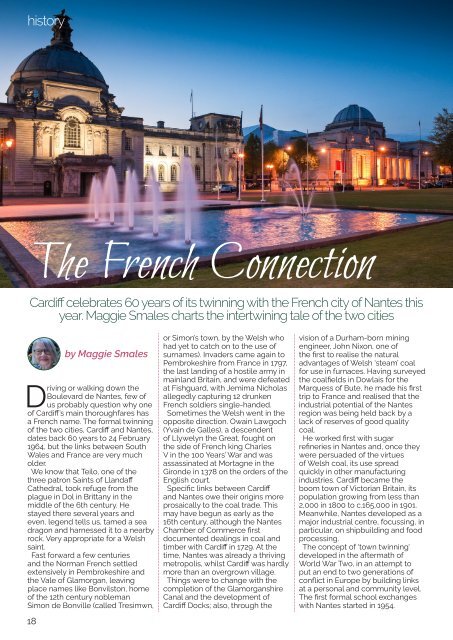You also want an ePaper? Increase the reach of your titles
YUMPU automatically turns print PDFs into web optimized ePapers that Google loves.
history<br />
The French Connection<br />
Cardiff celebrates 60 years of its twinning with the French city of Nantes this<br />
year. Maggie Smales charts the intertwining tale of the two cities<br />
by Maggie Smales<br />
Driving or walking down the<br />
Boulevard de Nantes, few of<br />
us probably question why one<br />
of Cardiff’s main thoroughfares has<br />
a French name. The formal twinning<br />
of the two cities, Cardiff and Nantes,<br />
dates back 60 years to 24 February<br />
1964, but the links between South<br />
Wales and France are very much<br />
older.<br />
We know that Teilo, one of the<br />
three patron Saints of Llandaff<br />
Cathedral, took refuge from the<br />
plague in Dol in Brittany in the<br />
middle of the 6th century. He<br />
stayed there several years and<br />
even, legend tells us, tamed a sea<br />
dragon and harnessed it to a nearby<br />
rock. Very appropriate for a Welsh<br />
saint.<br />
Fast forward a few centuries<br />
and the Norman French settled<br />
extensively in Pembrokeshire and<br />
the Vale of Glamorgan, leaving<br />
place names like Bonvilston, home<br />
of the 12th century nobleman<br />
Simon de Bonville (called Tresimwn,<br />
18<br />
or Simon’s town, by the Welsh who<br />
had yet to catch on to the use of<br />
surnames). Invaders came again to<br />
Pembrokeshire from France in 1797,<br />
the last landing of a hostile army in<br />
mainland Britain, and were defeated<br />
at Fishguard, with Jemima Nicholas<br />
allegedly capturing 12 drunken<br />
French soldiers single-handed.<br />
Sometimes the Welsh went in the<br />
opposite direction. Owain Lawgoch<br />
(Yvain de Galles), a descendent<br />
of Llywelyn the Great, fought on<br />
the side of French king Charles<br />
V in the 100 Years’ War and was<br />
assassinated at Mortagne in the<br />
Gironde in 1378 on the orders of the<br />
English court.<br />
Specific links between Cardiff<br />
and Nantes owe their origins more<br />
prosaically to the coal trade. This<br />
may have begun as early as the<br />
16th century, although the Nantes<br />
Chamber of Commerce first<br />
documented dealings in coal and<br />
timber with Cardiff in 1729. At the<br />
time, Nantes was already a thriving<br />
metropolis, whilst Cardiff was hardly<br />
more than an overgrown village.<br />
Things were to change with the<br />
completion of the Glamorganshire<br />
Canal and the development of<br />
Cardiff Docks; also, through the<br />
vision of a Durham-born mining<br />
engineer, John Nixon, one of<br />
the first to realise the natural<br />
advantages of Welsh ‘steam’ coal<br />
for use in furnaces. Having surveyed<br />
the coalfields in Dowlais for the<br />
Marquess of Bute, he made his first<br />
trip to France and realised that the<br />
industrial potential of the Nantes<br />
region was being held back by a<br />
lack of reserves of good quality<br />
coal.<br />
He worked first with sugar<br />
refineries in Nantes and, once they<br />
were persuaded of the virtues<br />
of Welsh coal, its use spread<br />
quickly in other manufacturing<br />
industries. Cardiff became the<br />
boom town of Victorian Britain, its<br />
population growing from less than<br />
2,000 in 1800 to c.165,000 in 1901.<br />
Meanwhile, Nantes developed as a<br />
major industrial centre, focussing, in<br />
particular, on shipbuilding and food<br />
processing.<br />
The concept of ‘town twinning’<br />
developed in the aftermath of<br />
World War Two, in an attempt to<br />
put an end to two generations of<br />
conflict in Europe by building links<br />
at a personal and community level.<br />
The first formal school exchanges<br />
with Nantes started in 1954.

















